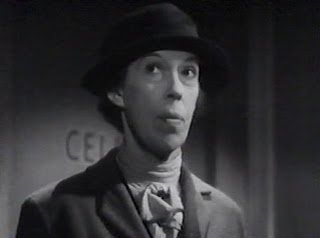Thursday, March 29, 2012
Murder on the Blackboard - 1934
“Murder on the Blackboard” (1934) keeps the teachers after school to find the killer when one of the staff is murdered. This is the second appearance of the superb Edna May Oliver as amateur sleuth and full-time teacher Hildegarde Withers. James Gleason is back as her foil and friend, Inspector Oscar Piper. They first teamed up for “Penguin Pool Murder” (1932), and would be back again for “Murder on a Honeymoon” (1935). Later entries in the series would feature Helen Broderick and Zasu Pitts in the role.
Caricatured by Hollywood cartoons for her weak chin and long face, but never as expertly as when she caricatured herself in every patented facial flinch and body English, Miss Oliver was perfectly cast in this role, bringing humor and depth, as she always did whatever part she played. One gets the sense she never considered any line a throw-away. Everything, like a good vaudevillian, was milked, every opportunity in script, in props, in gestures, was used to her advantage.
In this story, a young woman who was a fellow teacher is murdered in her New York school, and the cast of suspects includes two other teachers played by the ruggedly handsome Bruce Cabot, and by Gertrude Michael. They are in love, and secretly planning to marry. When Miss Michael is questioned, Mr. Cabot heroically comes to her defense. Miss Oliver responds,
“I like you for that, young man, but the police, though they may be fools, are not sentimental fools.”
She gets the best lines, and as usual in these stories, the cops are not as good at detective work as she is. A young Regis Toomey is James Gleason’s assistant. Gleason, though sometimes two steps behind Edna May, is no fool, and the repartee between them is funny, argumentative, and even awkwardly flirtatious. They are meant for each other.
One comic bit between them: He is about to help her through a trap door, and standing behind her, he grasps her underarms. She whoops and wiggles like a girl being fondled under the bleachers and remarks, “Oscar, this is no time for fooling.”
Annoyed at her misinterpretation, he drops her through the trap door like a sack of cement.
Gleason’s detective style is a bit more direct than Miss Oliver’s. He tells the principal, “Do you talk, or do I let the boys go to work on you?”
The smarmy principal, played by Tully Marshall, who chased the murder victim behind his wife’s back, is also under suspicion; as is the sloppy drunk janitor.
The title comes from a set of musical notes written on the blackboard by the murder victim, who taught music. One of the funny elements to the movie is that Edna May whistles the short series of notes to everyone she meets to try to judge their reaction and determine their guilt. They all look at her as if she is loony.
She sometimes comes off that way even to Gleason, who we see has great respect for her abilities. When they are in the hospital room of an injured police detective, the coroner, played by Gustav von Seyffertitz (who I have to mention just because I love his name so much) -- in the striking combination of wing collar and laboratory apron -- bows low and kisses Miss Oliver’s hand with European courtesy. They animatedly begin to discuss the details of the murder victim’s autopsy. The squeamish wounded policeman protests, and Gleason responds, “What do you care? You’re lucky they’re not both in bed with you.”
It is a movie that starts slow, but picks up with several excursions from the upper floors of classrooms to the cellar, where Edna May’s fluttering hands and occasional nervous nipping at from whatever bottle comes her way tell us that she is not yet hardened to this police work. However, when she knows the answer, she victoriously shouts “Eureka! I’ve got it!”
It’s a quick and neat little mystery, but the real charm is Edna May Oliver and James Gleason, most especially because they look like they’re having fun.
Subscribe to:
Post Comments (Atom)








No comments:
Post a Comment